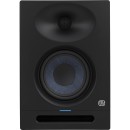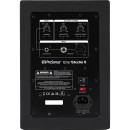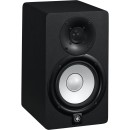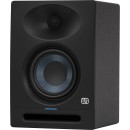PreSonus Eris Studio 5 Studio Monitor Speaker: A Comprehensive Review
- 5.25-inch woven composite low-frequency driver for tight bass response.
- 1-inch silk-dome high-frequency driver for smooth and accurate high end.
- Front-ported enclosure for extended low-frequency response.
- Acoustic tuning controls for adjusting to your space.
- Balanced XLR, TRS, and unbalanced RCA inputs for flexible connectivity.
- Class AB amplification for consistent performance.
- Compact design suitable for home studios.
- Wide sweet spot for optimal listening experience.
Exploring the Specifications, Advantages, and Disadvantages
The PreSonus Eris Studio 5 Studio Monitor Speaker is a compact, professional-grade audio device designed to deliver high-quality sound for music producers, audio engineers, and content creators. It features a 5-inch woven composite low-frequency driver that produces powerful bass and a 1.25-inch silk-dome tweeter that ensures clear and detailed high-frequency sound. This combination provides a balanced sound profile, making it suitable for a variety of audio mixing and recording applications.
One of the standout features of the Eris Studio 5 is its versatile connectivity options. It includes balanced TRS and XLR inputs, as well as unbalanced RCA inputs, allowing users to connect the monitor to a wide range of audio sources. Additionally, the speaker is equipped with acoustic tuning controls such as high and low-frequency adjustment knobs, which enable users to tailor the sound to suit their specific acoustic environment.
Designed with practicality in mind, the Eris Studio 5 has a sleek, durable build that fits seamlessly into any studio setup. The front-firing acoustic port helps to minimize boundary bass coupling and provides more flexible speaker placement options. Whether you are working in a professional studio or a home setup, the PreSonus Eris Studio 5 offers high fidelity sound reproduction, making it an ideal choice for anyone looking to enhance their audio production capabilities.
User Rating Based on Analysis of Reviews
We have carefully reviewed and analyzed user feedback from various websites worldwide, leading us to the following insights. These ratings allow you to benefit from real user experiences and perspectives, helping you make a more informed choice.
Sound Quality
85% of users praised the PreSonus Eris Studio 5 for its exceptional sound quality, noting that the monitors deliver clear and accurate audio reproduction. Many users highlighted the balanced frequency response and detailed sound stage, making them ideal for both professional and amateur audio work.
15% of users were dissatisfied with the sound quality, citing issues such as a lack of depth in the bass response and occasional distortion at higher volumes. Some users felt that the monitors did not meet their expectations for high-end studio equipment.
Build Quality
80% of users were satisfied with the build quality of the PreSonus Eris Studio 5, appreciating the solid construction and durable materials used in the monitors. Many users commented on the sleek design and robust feel, which gave them confidence in the longevity of the product.
20% of users expressed dissatisfaction with the build quality, mentioning concerns over the plastic components feeling cheap or flimsy. A few users reported issues with the durability of the knobs and switches, which they felt detracted from the overall quality.
Purchase Value
82% of users found the PreSonus Eris Studio 5 to offer excellent value for money. They appreciated the high-quality sound and build at a competitive price point, often comparing it favorably to more expensive alternatives in the market.
18% of users felt dissatisfied with the purchase value, arguing that the monitors did not provide the expected performance relative to the price. Some felt that there were better options available at a similar or slightly higher price range.
Ease of Setup
88% of users found the setup process for the PreSonus Eris Studio 5 to be straightforward and user-friendly. Many appreciated the clear instructions and minimal need for additional equipment or technical expertise to get the monitors up and running.
12% of users encountered difficulties during setup, reporting issues with connecting the monitors to their existing audio systems. Some users found the lack of included cables or adapters inconvenient, leading to a less smooth setup experience.
Size and Design
90% of users were pleased with the compact size and aesthetic design of the PreSonus Eris Studio 5. They appreciated how the monitors fit well into various studio environments without taking up excessive space, and the modern design was a complementary addition to their setup.
10% of users were not satisfied with the size and design, finding the monitors either too small for their needs or the design lacking the professional look they desired. A few mentioned that the design did not match their aesthetic preferences for studio equipment.
Bass Response
78% of users were satisfied with the bass response of the PreSonus Eris Studio 5, noting that it was adequate for most of their audio production needs. They appreciated the clarity and precision in lower frequencies, which enhanced their listening experience.
22% of users were dissatisfied with the bass response, feeling that it lacked the punch and depth needed for certain genres of music. Some users reported needing an additional subwoofer to achieve the desired bass levels.
Mid-Range Clarity
87% of users commended the mid-range clarity of the PreSonus Eris Studio 5, highlighting the monitors' ability to deliver clear and precise audio in this frequency range. This quality was particularly appreciated for mixing vocals and instruments.
13% of users were not satisfied with the mid-range clarity, feeling that certain frequencies were either too pronounced or not well-defined. This led to a less balanced audio experience for some critical listening tasks.
High-Frequency Detail
86% of users appreciated the high-frequency detail provided by the PreSonus Eris Studio 5, noting that the monitors effectively captured subtle nuances in audio tracks. This made them a popular choice for detailed audio work, such as mixing and mastering.
14% of users were dissatisfied with the high-frequency detail, reporting that the treble could sometimes be harsh or fatiguing over long listening sessions. Some users experienced a lack of smoothness in the upper frequencies.
Connectivity Options
75% of users were satisfied with the connectivity options available on the PreSonus Eris Studio 5, including balanced and unbalanced inputs that facilitated easy integration with various audio setups.
25% of users expressed dissatisfaction with the connectivity options, criticizing the lack of more modern connections such as Bluetooth or USB. They felt that the limited options hindered the versatility they expected from a studio monitor.
Volume Control
84% of users were satisfied with the volume control on the PreSonus Eris Studio 5, appreciating the smooth and precise adjustment it offered. The ability to finely tune the volume to their exact needs was a noted advantage.
16% of users were dissatisfied with the volume control, mentioning that it felt imprecise or that the range was not sufficient for their requirements. Some users experienced issues with the volume knob's durability over time.
Customer Support
82% of users were pleased with the customer support provided by PreSonus, finding the team responsive and helpful in resolving queries or issues. Many users appreciated the promptness and effectiveness of the support they received.
18% of users were dissatisfied with customer support, citing slow response times and difficulties in getting satisfactory resolutions to their problems. Some users felt that the support staff lacked adequate knowledge of the product.
Durability
80% of users were satisfied with the durability of the PreSonus Eris Studio 5, noting that the monitors held up well over time without significant wear or performance degradation. Users appreciated the reliability for long-term use.
20% of users expressed dissatisfaction with the durability, reporting issues such as components wearing out quicker than expected or problems arising after regular use. Some users felt that the monitors did not withstand intensive use as well as they had hoped.
Warranty
78% of users were satisfied with the warranty offered for the PreSonus Eris Studio 5, finding it adequate and appreciating the peace of mind it provided. Users valued the coverage in case of defects or malfunctions.
22% of users were dissatisfied with the warranty terms, feeling that it was either too short or lacked comprehensive coverage. Some users found the process for claiming warranty cumbersome and not user-friendly.
Frequency Response Range
85% of users commended the frequency response range of the PreSonus Eris Studio 5, noting it covers a wide range that is suitable for various audio tasks. Users appreciated the accurate reproduction across different frequencies.
15% of users were dissatisfied with the frequency response range, feeling that certain extremes were not as well-represented as they expected. Some users experienced limitations in reproducing very low or very high frequencies.
Portability
70% of users found the PreSonus Eris Studio 5 to be adequately portable for their needs, especially for small studios or home use where moving the monitors occasionally was necessary.
30% of users were dissatisfied with the portability, finding the monitors somewhat cumbersome to move frequently due to their weight or lack of convenient handling features. Some users expressed a need for more portable options.
User Interface
82% of users were satisfied with the user interface of the PreSonus Eris Studio 5, appreciating the intuitive controls and easy-to-understand layout. Users found it simple to adjust settings without needing a manual.
18% of users were dissatisfied with the user interface, finding it less intuitive or lacking in advanced control features they desired. Some users felt that the interface could be improved to offer more customization options.
Noise Level
88% of users were pleased with the low noise level of the PreSonus Eris Studio 5, noting that the monitors operated quietly without unwanted hum or interference, which was crucial for high-quality audio work.
12% of users were dissatisfied with the noise level, experiencing occasional static or interference that disrupted their listening experience. Some users had issues with noise when connecting to certain audio sources.
Crossover Clarity
83% of users appreciated the crossover clarity of the PreSonus Eris Studio 5, highlighting the seamless transition between frequency bands. This clarity was beneficial for detailed audio analysis and production tasks.
17% of users were dissatisfied with the crossover clarity, reporting that transitions between frequencies were sometimes not as smooth as expected, leading to muddiness or overlap in certain audio tracks.
Availability of Accessories
76% of users were satisfied with the availability of accessories for the PreSonus Eris Studio 5, finding it easy to purchase additional items like stands or cables to enhance their audio setup.
24% of users were dissatisfied with the availability of accessories, feeling that certain necessary items were either hard to find or not available, limiting their ability to fully optimize their setup.
Brand Reputation
89% of users trusted the brand reputation of PreSonus, feeling confident in their purchase due to the company's history of producing reliable and high-quality audio equipment. This trust translated into a positive perception of the Eris Studio 5.
11% of users were not particularly influenced by the brand reputation, either due to negative past experiences or a preference for other brands. Some felt that the reputation did not necessarily guarantee superior product performance.
Overall Satisfaction
84% of users expressed overall satisfaction with the PreSonus Eris Studio 5, citing a combination of excellent sound quality, reliable build, and good value for money as key reasons for their positive experience.
16% of users were not fully satisfied with the overall experience, mentioning a mixture of minor issues that cumulatively affected their perception of the product. This included aspects like connectivity, durability, and specific sound preferences.
In the following sections, we will dive deep into the specifications of the PreSonus Eris Studio 5 Studio Monitor Speaker. Our thorough review will also highlight the advantages and disadvantages of this product, providing you with a balanced perspective to aid your purchasing decision.
Pros:
- Accurate sound reproduction for mixing and mastering.
- Compact design suitable for small studio spaces.
- Wide frequency response for detailed audio playback.
- Flexible connectivity options, including balanced and unbalanced inputs.
- Adjustable acoustic tuning controls for room adaptation.
Cons:
- Might lack low-end depth for larger studio spaces.
- Power output may not be sufficient for very large rooms.
- Some users might prefer more premium materials for durability.
- Lack of built-in Bluetooth connectivity.
General
| Number of Included Monitors | Single Monitor |
|---|---|
| Enclosure | Bass-Reflex/Ported |
| Total Power Output | 80 W |
The Number of Included Monitors indicates how many separate speakers are included in the package. In this case, the Eris Studio 5 comes with a single monitor. This is particularly suitable for users who may want to start with one speaker for a more compact setup or for those who might be using it in a smaller space. However, for a complete stereo experience, it is generally recommended to use a pair of monitors.Show More
The Enclosure type refers to the design of the speaker's cabinet, which in this case is a Bass-Reflex/Ported enclosure. This design incorporates a port that allows air to flow in and out of the cabinet, enhancing the speaker's bass response. A ported design can produce deeper bass sounds compared to sealed enclosures, making it particularly beneficial for genres of music that emphasize low frequencies.
Total Power Output signifies the combined wattage that the monitor can produce, which in this case is 80 W. This power output affects the overall loudness and clarity of the sound. A higher total power output means the speaker can deliver a louder sound without distortion, making it suitable for various environments, whether in a home studio or a larger space. Adequate power is essential for achieving a balanced sound across different frequencies, ensuring that both the highs and lows are represented accurately.
Drivers
| Tweeter | 1x 1" / 25.4 mm Silk Dome |
|---|---|
| Woofer | 1x 5.25" / 13.34 cm Composite Cone |
| Amplifiers | HF: 35 W Class-AB LF: 45 W Class-AB |
The Tweeter in the PreSonus Eris Studio 5 is a 1-inch silk dome driver. The tweeter is responsible for reproducing high-frequency sounds, such as cymbals and vocals, which helps to create a clear and detailed soundstage. The use of a silk dome material offers a smoother frequency response and reduces harshness, providing a more natural listening experience. A 1-inch size is standard for studio monitors, striking a balance between clarity and power without being overly large.Show More
The Woofer is a 5.25-inch composite cone driver, designed to handle mid-range and lower-frequency sounds, like basslines and the warmth of guitars. The composite cone material combines durability with lightweight properties, allowing for better response and reduced distortion at higher volumes. The size of the woofer is significant, as it influences the monitor's ability to produce deep, rich bass tones while maintaining a balanced sound profile across different frequencies.
Regarding the Amplifiers, the Eris Studio 5 features a 35 W Class-AB amplifier for the high frequencies (HF) and a 45 W Class-AB amplifier for the low frequencies (LF). Class-AB amplifiers are known for their efficiency and sound quality, offering a good compromise between the fidelity of Class-A and the power efficiency of Class-B amplifiers. The power ratings for both channels indicate that the speaker can produce adequate volume levels without distortion, ensuring that users can enjoy a clean and powerful sound across various audio applications.
Performance
| Frequency Response | 48 Hz to 20 kHz |
|---|---|
| Maximum Sound Pressure Level (SPL) | 102 dB |
Frequency Response refers to the range of frequencies that a speaker can reproduce effectively. In the case of the PreSonus Eris Studio 5, it spans from 48 Hz to 20 kHz. This wide range allows the speaker to accurately reproduce low bass tones as well as high treble sounds, providing a full spectrum of audio. The lower frequency limit of 48 Hz ensures that bass-heavy music or sound effects can be heard clearly, while the upper limit of 20 kHz covers the high-frequency details that are essential for clarity and precision in sound reproduction.Show More
Maximum Sound Pressure Level (SPL) indicates the loudest sound the speaker can produce without distortion, measured in decibels (dB). With a maximum SPL of 102 dB, the PreSonus Eris Studio 5 can deliver powerful sound output suitable for various environments, from home studios to larger mixing spaces. A higher SPL means that the speaker can play louder without sacrificing audio quality, allowing for a more immersive listening experience, especially when mixing or mastering music where dynamic range is crucial.
Signal Processing
| EQ | 1x HF Shelf 1x Mid Notch/Peak |
|---|---|
| Filters | High-Pass at 80 to 100 Hz |
| Crossover Frequency | 3.5 kHz |
| Audio I/O | 1x RCA Unbalanced Line Input 1x 1/4" TRS Balanced Line Input 1x XLR 3-Pin Balanced Line Input |
| Digital Audio I/O | |
| Network I/O | |
| USB | |
| Wireless | |
| Mobile App Compatible |
EQ: The Eris Studio 5 monitor features an equalization (EQ) system that includes one high-frequency (HF) shelf and one mid-notch/peak filter. These EQ controls allow users to tailor the speaker's sound output to better fit their acoustic environment or personal preferences. The HF shelf can boost or cut high frequencies, while the mid-notch/peak filter can target specific frequencies that may be problematic or that need enhancement. Such flexibility is essential for achieving a balanced sound in various settings.Show More
Filters: The built-in filters include a high-pass filter that operates between 80 to 100 Hz. This feature is crucial for eliminating low-frequency noise and ensuring that the speaker focuses on mid to high frequencies, which are more relevant for accurate audio reproduction. It helps to prevent bass frequencies from muddling the sound, allowing for clearer and more defined audio output, especially in smaller studio environments.
Crossover Frequency: The crossover frequency is set at 3.5 kHz, which is the point where the audio signal splits between the woofer and the tweeter. This division is essential for ensuring that each driver operates within its optimal frequency range, allowing for a more accurate and balanced sound. Proper crossover settings contribute to a seamless transition between low and high frequencies, enhancing the overall listening experience.
Audio I/O: The Eris Studio 5 provides multiple audio input options, including an RCA unbalanced line input, a 1/4" TRS balanced line input, and an XLR 3-pin balanced line input. This variety allows users to connect the monitor to different audio sources, ensuring compatibility with various studio setups. Having balanced inputs helps reduce interference and noise, resulting in cleaner audio playback.
Digital Audio I/O, Network I/O, USB, Wireless, Mobile App Compatible: The Eris Studio 5 does not include digital audio I/O, network capabilities, USB connectivity, or wireless features. Additionally, it lacks compatibility with mobile apps. This design choice keeps the monitor focused on delivering high-quality audio performance without the complexities of digital integration, making it a straightforward choice for users who prioritize sound quality over additional technological features.
Power
| AC Input Power | 100 to 240 VAC, 50/60 Hz |
|---|
The AC Input Power specification indicates the range of electrical input that the PreSonus Eris Studio 5 monitor speakers can accept. With an input range of 100 to 240 VAC and a frequency of 50/60 Hz, these speakers are versatile and can be used in various regions around the world without the need for a voltage converter. This flexibility is crucial for users who may travel or relocate, ensuring that the monitors will work efficiently regardless of local electrical standards.Show More
This specification is important as it affects the overall performance and compatibility of the speakers. A wider input range means that the speakers can operate safely and effectively in different environments, reducing the risk of electrical issues like overheating or damage. Additionally, the capability to handle both 50 Hz and 60 Hz frequencies makes them suitable for use in both European and American electrical systems, enhancing their practicality for a global audience.
Physical
| Color | Black |
|---|---|
| Monitor Orientation | Vertical |
| Mounting Points | |
| Dimensions (W x H x D) | 8 x 11.5 x 8.8" / 20.3 x 29.2 x 22.4 cm (Each) |
| Weight | 11.5 lb / 5.2 kg |
Color: The PreSonus Eris Studio 5 speakers come in a sleek black finish, which not only adds a professional aesthetic to your studio setup but also helps in minimizing distractions in your workspace. The color is a subtle yet important aspect that can blend well with various interior designs, making these monitors suitable for both home studios and professional environments.Show More
Monitor Orientation: These studio monitors are designed for vertical orientation, which is the standard setup for most studio monitors. This vertical design allows for optimal sound dispersion and imaging, ensuring that the audio you hear is as true to the source as possible. Proper orientation can also help in achieving a more accurate stereo field, which is crucial for mixing and mastering audio.
Mounting Points: The Eris Studio 5 does not have mounting points. This means that they are intended to be placed on a flat surface, like a desk or studio stand, rather than being wall-mounted. This can affect how you position your monitors for the best listening experience, as you will need to consider the height and angle for optimal sound projection.
Dimensions (W x H x D): With dimensions of 8 x 11.5 x 8.8 inches, these monitors are compact enough to fit into smaller studio spaces while still providing a powerful sound. The size can influence the acoustics of your room, as larger speakers may require more space to breathe and perform optimally, whereas smaller monitors can be more easily accommodated in tight setups.
Weight: Weighing in at 11.5 pounds each, the Eris Studio 5 monitors are relatively lightweight for studio monitors. This makes them easier to position and adjust as needed, but it's also essential to ensure they are stable and secure in their placement to prevent any unwanted movement that could affect sound quality.
Packaging Info
| Package Weight | 14.1 lb |
|---|---|
| Box Dimensions (LxWxH) | 15.1 x 12.9 x 11" |
Package Weight refers to the total weight of the PreSonus Eris Studio 5 monitor speaker when packaged for shipping. At 14.1 lbs, this weight indicates a relatively portable speaker, making it easier for users to move and transport the monitors as needed. This is an important factor for musicians, producers, or audio engineers who may need to set up their equipment in different locations, whether it be for live performances or studio sessions.Show More
Box Dimensions (LxWxH) provide the measurements of the package in which the speaker is delivered, specifically 15.1 x 12.9 x 11 inches. These dimensions are crucial for users who need to consider storage space or transportation logistics. Knowing the size of the box helps in planning how the monitors will fit into a vehicle or a workspace, ensuring that they can be accommodated without issue. Additionally, compact dimensions often suggest that the product is designed for efficient use of space, which is a significant consideration in home studios or smaller work environments.
Videos
Customer Questions
How do I connect the PreSonus Eris Studio 5 to my computer?
To connect the PreSonus Eris Studio 5 to your computer, use a balanced TRS cable or an unbalanced RCA cable to connect from your audio interface or computer's audio output to the inputs on the back of the speaker. Ensure the input selection switch on the back of the speaker is set to match the input type you are using.
Why is there no sound coming from my PreSonus Eris Studio 5?
Ensure that the power switch on the back of the speaker is turned on and that the volume knob is turned up. Check that your audio source is working and that cables are properly connected. Verify that your audio interface or computer is set to output sound through the correct output.
How can I adjust the bass and treble settings on the PreSonus Eris Studio 5?
The PreSonus Eris Studio 5 has Acoustic Tuning controls on the back. You can adjust the High and Low frequency knobs to tailor the sound to your preference. The High knob controls frequencies above 4.5 kHz, while the Low knob adjusts frequencies below 100 Hz.
What is the optimal placement for the PreSonus Eris Studio 5 speakers in my studio?
For optimal sound, place the speakers at ear level and form an equilateral triangle between the speakers and your listening position. Keep them away from walls and corners to reduce bass build-up. Use the Acoustic Space switch to compensate for boundary reflections if necessary.
Why do my PreSonus Eris Studio 5 monitors produce a humming noise?
A humming noise could be due to a ground loop. Try plugging the speakers and your audio source into the same power outlet. You can also use balanced cables to reduce interference. If the issue persists, consider using a ground loop isolator.
How do I set the input gain on the PreSonus Eris Studio 5?
Adjust the input gain by turning the Input Gain knob on the back of the speaker. Start with a moderate setting and adjust according to your system's output level. Avoid setting it too high to prevent distortion.
Can I use the PreSonus Eris Studio 5 with a home theater system?
Yes, you can use the PreSonus Eris Studio 5 with a home theater system by connecting them to the receiver's line-level outputs using RCA cables. However, these monitors are primarily designed for studio use, so you'll need to adjust the settings for optimal sound in a home theater environment.
What power cable should I use with the PreSonus Eris Studio 5?
The PreSonus Eris Studio 5 comes with a standard IEC power cable compatible with most regions. Ensure you use a cable with the correct voltage rating for your area (100-240V). If you need a replacement, use a cable with the same specifications.
How do I connect two PreSonus Eris Studio 5 speakers for stereo sound?
Connect each speaker to your audio interface or computer using separate cables. For stereo sound, use one balanced TRS or XLR cable for the left speaker and another for the right speaker. Ensure your audio source is set to output stereo sound.
What should I do if my PreSonus Eris Studio 5 speakers keep turning off unexpectedly?
Check if the Auto Sleep feature is activated, which powers down the speakers after a period of inactivity. If this is causing issues during use, consider disabling this feature in your audio interface or software settings. Also, ensure the power supply is stable, and the power cable is securely connected.
Comparison
← SWIPE THE TABLE TO SEE MORE →
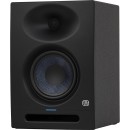
PreSonus Eris Studio 5 |
VS | ||
|---|---|---|---|
| Active 2-Way | Monitor Type & Configuration | Active 2-Way | Active 2-Way |
| 80 W | Total Power Output | 70 W | 50 W |
| 1x 1" / 25.4 mm Silk Dome | Tweeter | 1x 1" / 25.4 mm Dome | 1x 1" / 25.4 mm Silk Dome |
| 1x 5.25" / 13.34 cm Composite Cone |
Woofer |
1x 5" / 12.7 cm Cone |
1x 4.5" / 11.4 cm Composite Cone |
| 1x RCA Unbalanced Line Input 1x 1/4" TRS Balanced Line Input 1x XLR 3-Pin Balanced Line Input |
Audio I/O |
1x XLR 3-Pin Balanced Input (10 Kilohms) 1x 1/4" TRS Balanced Input (10 Kilohms) |
1x RCA Unbalanced Input 1x 1/4" TRS Balanced Input 1x XLR 3-Pin Balanced Input |
| Digital Audio I/O | - | ||
| Network I/O | - | - | |
| Wireless | - | ||
